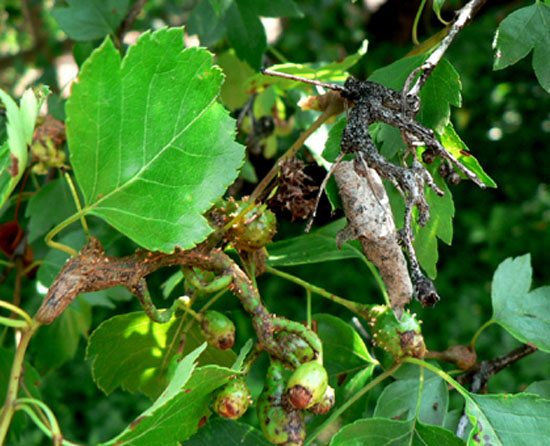Issue 11, July 2, 2009
Cedar-Quince Rust
Cedar-quince rust is caused by a fungal pathogen called Gymnosporangium clavipes. This fungus infects more than four hundred and eighty plant species in eleven genera in the rose family, including mountain ash, hawthorn, quince, flowering quince, serviceberry and apple. Possible evergreen hosts include Eastern red cedar (Juniperous virginiana), common (J. communis), creeping (J. horizontalis), Rocky Mountain (J. scopulorum) and savin junipers (J. sabina). In order to survive, the fungus must "move" from an evergreen host to a deciduous host.
On evergreen hosts, infection occurs on needles and new shoots. This rust causes rough looking branch swellings. Most of the infected tissue dies after the telial stage of the fungus forms, killing small twigs. Sometimes the fungus becomes perennial, and infected tissue elongates slightly each year. Most landscapers are familiar with the roundish galls of two related rusts, cedar apple rust and cedar hawthorn rust, but many have never noticed the cedar-quince rust galls which appear as branch swellings. Once the fungus become wet, it swells, becomes gelatinized, and appears bright orange. The image shows a juniper host with round galls of cedar-apple rust on the left and stem swellings of cedar-quince rust on the right.

On deciduous hosts, leaves, petioles, young branches and fruit are usually infected, and symptoms vary widely among the various hosts. Hawthorns and serviceberries are common deciduous hosts of cedar-quince rust. Pinkish fruiting bodies (aecia) develop mainly on branches, thorns, and the fruit of hawthorn, while foliage may be free of infection. Both hawthorn and serviceberry fruit often becomes heavily covered with aecia. Hawthorn branches develop swollen cankers much like those on the evergreen host. These cankers girdle stems and cause die-back on most infected branches. Galls become black by mid-summer. The infection of thorns, stems and fruit also help separate quince rust from apple and hawthorn rusts. The second image shows a hawthorn infected with cedar-quince rust. You can see young stem galls on the left, old stem galls on the right, uninfected leaves, and infected fruit.

The Disease Cycle: Stem swellings (telia) on the evergreen host develop quickly in wet spring weather. The telia develop teliospores which then form basidiospores. The basidiospores are blown or splashed onto the deciduous hosts such as hawthorn. With adequate moisture, infection can occur between 36° and 75°F. Severe infection can occur between 50° and 75°F. Seven to ten days after infection, spots or swellings develop on the deciduous host leaves. Several days later, the formation of tiny black dots (spermagonia) develop within the spots. Weeks later, aecia are formed. Aeciospores are released from the aecia during rain or as morning humidity lowers. The spores become airborne and infect susceptible evergreen hosts during late summer and fall. Swellings (both fungal and host plant tissue) develop on the evergreen host the following spring. Once the swellings are mature, a few hours of wet, cool spring weather is sufficient for repeated telial swelling and the release of the basidiospores. The cycle continues in this manner from year to year.
Cedar-quince rust has become a problem in the Illinois landscape. Grow resistant varieties whenever possible. Follow good cultural practices and remove as much of the infected twigs, fruit and leaves as possible. Do this in dry weather to prevent further spread of spores. If infection is severe, consider following recommended fungicide treatments as listed in the Illinois Commercial Landscape and Turfgrass Pest Management Handbook or the Home, Yard, and Garden Pest Guide.--James Schuster
Author:
Jim Schuster